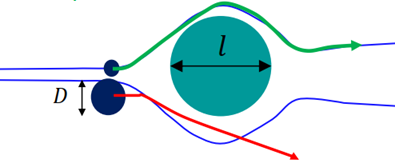Subgrid Transition Model Reference
The Subgrid Transition model allows you to identify very small Lagrangian parcels and transition them to an MMP phase. Mass, momentum, and energy are conserved in the transition. This model is meant to be used as part of a hybrid multiphase approach where the Mixture Multiphase (MMP) model is used alongside the Lagrangian Multiphase (LMP) model.
The Subgrid Transition model transitions small Lagrangian parcels such as aerosolized droplets (mists) to an MMP phase, thereby reducing computational expense. The transitioning from sub-grid size Lagrangian parcels to an MMP phase volume fraction is based on user-defined transition criteria. The Subgrid Transition model accumulates the volume, momentum, and energy of Lagrangian parcels that satisfy the transition criteria and transitions these properties to the MMP phase at each Lagrangian sub time-step.
| Provided By | |||
| Example Node Path | |||
| Requires |
An MMP Multiphase simulation with the Lagrangian Multiphase model activated. The MMP phase and the corresponding Lagrangian phase defined. MMP-Lagrangian Phase Interaction with the MMP phase and the corresponding Lagrangian phase selected. |
||
| Properties | None. | ||
| Activates | Physics Models | None. | |
| Model Controls (child nodes) | Lagrangian-Eulerian Transition Criteria | ||
| Field Functions | See Lagrangian-Eulerian Transition Criteria Field Functions. | ||
Lagrangian-Eulerian Transition Criteria
- Right-Click Actions
-
- Creates a new criterion for the transition of small (sub-grid) Lagrangian parcels to an MMP phase based on the diameter of the Lagrangian parcels.
- Creates a new criterion for the transition of small (sub-grid) Lagrangian parcels to an MMP phase based on the Stokes number of the Lagrangian parcels.
- Creates a new user defined criterion for the transition of small (sub-grid) Lagrangian parcels to an MMP phase.
- Particle Diameter Criterion
- Defines the Lagrangian-Eulerian transition
of sub-grid Lagrangian particles based on the diameter of each particle. The
Lagrangian parcels whose diameter is smaller than the host cell size
transition onto the MMP phase, maintaining the volume. Lagrangian parcels
whose diameter is greater than the host cell size do not transition.

- Stokes Number Criterion
-
Specifies a transition criterion that is based on the Stokes number of the Lagrangian parcels. This Stokes number is defined as:(305)where:
- the characteristic length scale.
- is the particle density.
- is the particle diameter.
- is the particle velocity.
- is the continuous phase velocity.
- is the dynamic viscosity of the continuous phase.
- User Defined Criterion
-
An optional user defined transition criterion. Lagrangian parcels with a value of 1 for this property transition to MMP. Parcels with a value of zero remain as a Lagrangian phase.
| 注 | Lagrangian-Eulerian transition takes place only for those Lagrangian parcels that satisfy all the criteria that are set under the Lagrangian-Eulerian Transition Criteria node. |
Lagrangian-Eulerian Transition Criteria Field Functions
The following field function are available with the Lagrangian-Eulerian Transition Criteria node:
- Integrated TransitionMark of [phase interaction]
- Gives the integrated results for all the defined transition criteria. A value of indicates which Lagrangian parcels transition to an MMP phase at any given time-step.
- TransitionMark of Particle Diameter Criterion of [phase interaction]
-
Provides the particle diameter criterion transition mark. A value of 1 indicates which Lagrangian parcels satisfy the particle diameter criterion and are candidates for transitioning to an MMP phase at any given time-step.
- TransitionMark of Stokes Number Criterion of [phase interaction]
- Provides the Stokes number criterion transition mark. A value of 1 indicates which Lagrangian parcels satisfy the Stokes number criterion and are candidates for transitioning to an MMP phase at any given time-step.
- TransitionMark of User Defined Criterion of [phase interaction]
- Provides the transition mark when a User Defined criterion is used for the Lagrangian-Eulerian Transition Criteria. A value of 1 indicates which Lagrangian parcels satisfy the User Defined criterion and are candidates for transitioning to an MMP phase at any given time-step.
- Mmp-Lagrangian Continuity Source of [phase interaction]
- The continuity source term from the subgrid transition of Lagrangian parcels to an MMP phase.
- Mmp-Lagrangian Energy Source of [phase interaction]
- The energy source term from the subgrid transition of Lagrangian parcels to an MMP phase.
- Mmp-Lagrangian Momentum Source of [phase interaction]
- The momentum source term from the subgrid transition of Lagrangian parcels to an MMP phase.
- Mmp-Lagrangian Component Source of [mixture component] of [phase interaction]
- The species component source terms from the subgrid transition of Lagrangian parcels to an MMP phase. This field function is available for multi-component phases only.
